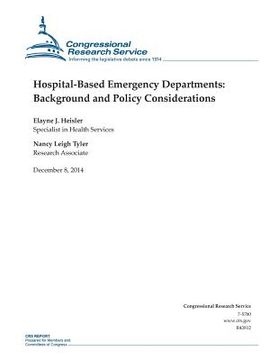Hospital-Based Emergency Departments: Background and Policy Considerations (en Inglés)
Reseña del libro "Hospital-Based Emergency Departments: Background and Policy Considerations (en Inglés)"
Hospital-based Emergency Departments (EDs) are required to stabilize patients with emergent conditions regardless of the patients' ability to pay as a requirement of the Emergency Medical Treatment and Active Labor Act (EMTALA). Given this requirement, EDs play an important part in the health care safety net by serving the uninsured, the underserved, and those enrolled in Medicaid. Open 24 hours a day, EDs provide emergency care, urgent care, primary care, and behavioral health care services in communities where these services are unavailable or unavailable after hours. EDs also play a key role during emergencies, such as natural disasters. Some EDs are challenged to provide effective care. For example, EDs provide a disproportionate amount of health care to the U.S. population, in general, and to the safety net population, in particular. Specifically, while 4% of all U.S. physicians are ED physicians, they are the treating physicians in 28% of all acute care visits. Some EDs face financial challenges. ED services are costly both to payers, because services provided in an ED are more costly than those provided in community-based settings, and to hospitals, because operating an ED has high fixed costs and because if patients enter with an emergent condition, hospitals are required by EMTALA to stabilize the patient regardless of the patient's ability to pay. As providers of uncompensated safety net care, some EDs are crowded, in part because hospitals lack staff or inpatient beds to transfer patients from the ED, and in part because of the large number of patients who seek care in the ED because care is unavailable or inaccessible in the community. Crowded conditions have resulted in some patients experiencing long wait times, which, at times, delays access to care and results in worse health outcomes. In addition, hospitals, particularly those in urban areas, are regularly diverting ambulances because they are too crowded to accept new patients. This report describes EDs and the role they play in the health care delivery system. It also discusses the federal role and interest in supporting emergency care. The federal government is the largest payer for overall health care, through the Medicare and Medicaid programs. Also, the federal government has made investments in emergency preparedness, programs and efforts that support the health care safety net, and health care access in general. Given these investments, Congress may be interested in EDs because a well-functioning ED system is necessary to provide surge capacity in an emergency. The function of the ED system, in turn, reflects its surrounding community's access to health care services; therefore, understanding the use of EDs, evaluating whether such use is appropriate, and examining strategies employed to reduce inappropriate use may all be of policy interest. This report discusses three commonly identified and interrelated challenges that EDs face: (1) crowding in EDs, (2) providing repeat care to a subset of patients who are frequent users, and (3) providing care to a large population who have behavioral health conditions when an ED lacks the appropriate resources to provide such treatment. Finally, this report concludes with some policy options that Congress might consider to improve ED functioning and reduce payer costs. This report focuses on EDs that are available to the general population; as such, it does not include EDs operated by the Departments of Defense or Veterans Affairs or those operated by the Indian Health Service.

